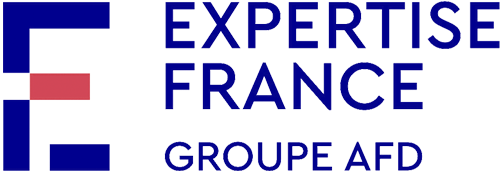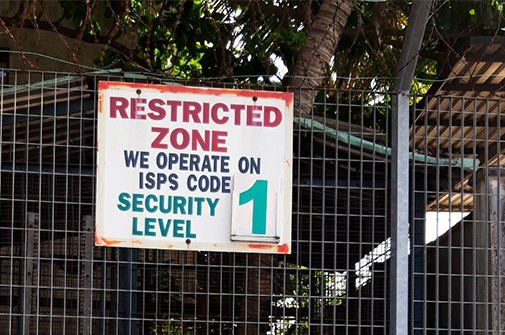Security objective: WeCAPS project and upgrading port facilities to ISPS standards

Christophe Van Maele is a specialist in port management and the implementation of ISPS security projects in ports and port facilities. He has over 30 years of experience in maritime ports, firstly as a Merchant Navy Officer, then as a member of the management committee of several shipping companies and, since 2004, as an ISPS security expert. He joined WeCAPS in 2019 as an ISPS expert, where his role is to advise African ports and help them improve their level of ISPS security, including for the prevention of terrorist attacks.
Maritime ports play an extremely important role in countries that depend on foreign trade, particularly West and Central African countries where the sea is often the only gateway to the international market. Unfortunately, they are regularly exposed to various malicious acts. Can you tell us a bit more about the threats that particularly affect this area of the world and why?
Christophe Van Maele – West and Central Africa face various types of potentially serious risks related to security. In addition to illegal fishing, there are four major types of threats to security in this region: drug trafficking, organised crime, terrorism and piracy.
 Four major threats to security in West and Central Africa
Four major threats to security in West and Central Africa
Growing demand for cocaine in Europe has logically led to an increase in shipments from South America to Europe. As the direct maritime routes from this region to Europe have attracted the attention of customs officials and are therefore subject to more frequent controls of ships, drug traffickers have turned to West Africa as a transit area to route all kinds of illegal drugs to Europe, including heroin and cocaine. Small planes and small or medium-sized vessels are used to transport drugs from South America to West Africa. The drugs are subsequently repackaged in the region and transported to Europe on commercial aircraft, but also by sea and via the Sahara Desert.
Organised crime also includes the traditional theft of cargo, smuggling, arms and human trafficking, fraud, theft of port equipment and port cybercrime. In recent years, ports all over the world have experienced a digital transformation in order to optimise existing processes and introduce new levels of efficiency. This digital transformation has also led to an increase in cyber risks in ports, as certain cyber safety incidents have shown in recent years: the cyber attack against the port of Antwerp, the NotPetya ransomware incident and its impact on Maersk and the wave of attacks and ransom requests in the ports of Barcelona and San Diego. Cyber safety risks are often seriously underestimated by ports and could already be latent in a port until the right time comes to take action and attack the computer systems.
In terms of terrorist actions, in Western African coastal countries, we have seen a fivefold increase in the number of victims of these attacks, from 800 to over 4,000 in four years. These attacks can threaten maritime port activities. Maritime piracy has increased in the Gulf of Guinea, despite the preventive measures, and abductions of crew members have become one of the main ways for payment of ransoms. By comparison, attacks against the cargo or ship itself have declined in this region. These abductions have a potentially high success rate as maritime companies and the families of crew members are more willing to pay a lower ransom to free their loved ones than a ransom of several million euros to free an entire ship.
 The objective of WeCAPS is to help ports manage risks
The objective of WeCAPS is to help ports manage risks
The objective of the WeCAPS project is to help ports manage risks, both security and safety risks. Accidental or malicious actions can lead to the same disastrous result, causing major damage to the port and paralysing the economic maritime flow to and from Europe, for example. The tragedy at the Port of Beirut could also happen at another port if a terrorist could get into an inadequately secured port facility and blow up a vulnerable warehouse.
In addition to these threats, the issue of the penetrability and therefore the security of ports also depends on the implementation of the standards of the International Ship and Port Security Code – the ISPS code. Can you remind us what this code is and give us examples of how it is actually implemented in a port?
Christophe Van Maele – Through the extent of their territory, the high seas are considered as a highly vulnerable area where it is easier for criminals to board vessels and commit acts of piracy. To protect the maritime sector, the International Maritime Organization (IMO) has developed the International Ship and Port Security Code, the ISPS code. This code establishes a minimum level for the security measures to take, the coordination between the various authorities and the control of the implementation of the regulations. It is a full set of measures that aims to strengthen the security of ships and port facilities.
 The ISPS code establishes a minimum level for the security measures to take
The ISPS code establishes a minimum level for the security measures to take
All IMO member ports involved in international maritime transport and all the terminals receiving seagoing ships of less than 500 gross tonnage and sailing on international voyages must adhere to the necessary ISPS measures. Each ISPS port facility must have an officially approved security plan, which must be rigorously applied in practice. These facilities will have to apply several procedures by level of security, monitor their perimeter, their surface area, and will ensure there is a certain form of access control.
 The challenge, seen in ports all over the world, lies in maintaining stringent ISPS rules
The challenge, seen in ports all over the world, lies in maintaining stringent ISPS rules
Most ports in Africa and beyond have implemented the ISPS code in their facilities and use the practical code of Geneva concerning security in entire ports. The challenge, seen in ports all over the world, lies in maintaining stringent ISPS rules in order to maintain a high level of professional security over the long term.
When this code came into force, ports in West and Central Africa, like the other ports in the world, showed great interest in the application of these new standards. Yet for the time being, many African ports still do not manage to fully respect the provisions of this code. How does the WeCAPS project intend to support them?
Christophe Van Maele – Maritime transport is a crucial activity between Africa and Europe. It is estimated that 90% of traffic to and from Africa goes by sea. In addition, West and Central African ports provide essential facilities for the distribution of goods to and from countries without maritime borders. The European Union has over 1,200 maritime ports that allow goods to be imported and exported, energy to be supplied and passengers and vehicles to be transported to and from Africa.
 It is estimated that 90% of traffic to and from Africa goes by sea
It is estimated that 90% of traffic to and from Africa goes by sea
Each port has its own DNA, interests, challenges and activities. In Central and Western Africa, the situation is no different. Many maritime ports there face challenges in monitoring the proper implementation of the security regulations and ISPS code.
Given the risk factors facing this critical infrastructure, WeCAPS has been set up to ensure the security of port facilities in West and Central Africa. It is funded by the European Union and managed by Expertise France and is in line with the EU maritime strategy on the Gulf of Guinea and the 2013 Yaoundé Process. One of its objectives is to help the authorities strengthen the security of their ports. It aims to strengthen the security of maritime trade between Africa and Europe by increasing mutual benefits through the creation of economic and social stability. The European Union provides assistance to African ports to prevent possible criminal or terrorist actions in a port that are likely to disrupt the economic flow between Africa and Europe.
 WeCAPS takes a cooperative approach
WeCAPS takes a cooperative approach
WeCAPS goes beyond the application of the ISPS code and takes a cooperative approach to implement and/or improve port security. Best practices are shared through technical advice, ISPS training and the delivery of small equipment.
For several years, the threats seen in West and Central African ports have, as you said earlier, concerned acts of piracy, armed robbery, all types of trafficking and illegal fishing. Yet these malicious acts or thefts start on land. So, beyond the port aspect, shouldn’t we also take into account the security of the entire logistics chain and land transport? Is this planned by the WeCAPS project?
Christophe Van Maele – WeCAPS completes a series of maritime security projects led by Expertise France and supported by the European Commission, such as CRIMARIO in the Indian Ocean and GoGIN in the Gulf of Guinea, which aim to promote interregional cooperation on maritime safety and security.
The role of WeCAPS is specifically adapted to help maritime ports. It is linked to the other projects but has nothing to do with improving security in the other areas of the logistics chain.
The specific aspect of WeCAPS lies in the fact that it focuses on ports in West and Central Africa, as they play a crucial role in the maritime economic flow and must be protected in the same way as ships, the ocean itself and the other ports of call in Europe.
The attractiveness and security of ports in a broad sense can only be ensured by an approach that makes security an aspect of the quality of service expected by the various maritime stakeholders. By strengthening the security of ports in West and Central Africa, is WeCAPS therefore also committed to promoting the economic development of their countries?
Christophe Van Maele – The risk for a port is that one or several of its terminals may be more or less compliant with ISPS standards: this could lead to ships avoiding the port or looking for other ports that do not require additional security measures or do not involve high insurance costs. This can result in serious economic consequences as fewer goods will be handled by their port and its income would fall.
 The implementation of an appropriate ISPS policy is a real marketing instrument
The implementation of an appropriate ISPS policy is a real marketing instrument
In addition, the implementation of an appropriate ISPS policy in a port is a real marketing instrument which shows maritime stakeholders that the port offers a safe and secure environment for ships. It leads to better quality operations and a more effective management of the port. This is a unique selling point, a mechanism that makes it possible to stand out from competing ports and would lead to an economic recovery for the port and the country.
Today, port authorities are mainly responsible for securing maritime ports in West and Central Africa, yet securing them requires a real synergy of actions. In your opinion, which stakeholders would also have a key role to play in the achievement of this objective? What is the European Union’s position through the WeCAPS project?
Christophe Van Maele – The ISPS port security space is the area located inside the administrative boundaries of the port and the port authority is the first entity to handle it when an incident occurs. However, the port has the advantage of being able to use national security laws and other specific regional laws on how to manage security risks.
 The key to the success of a security policy in a port is the level of cooperation between these various stakeholders
The key to the success of a security policy in a port is the level of cooperation between these various stakeholders
The various stakeholders play a specific role in securing maritime ports. They need to have a real synergy of communication and cooperation to achieve the objective of keeping the port safe. The various stakeholders may be the maritime police, the military naval forces, the port authorities, the merchant navy, the prefect and the customs authorities, but there can be more of them depending on the national security laws. The key to the success of a security policy in a port is the level of cooperation between these various stakeholders. The European Union, through the WeCAPS project, plays an advisory and support role, by sharing its good practices and a portfolio of European experience in this field.
Funded by the European Union and implemented by Expertise France, the WeCAPS project is part of the Critical Maritime Routes (CMR) programme, a framework action funded by the European Union that aims to improve the security and safety of maritime routes in the Gulf of Guinea and extended Indian Ocean area.
 More about the project WeCAPS project
More about the project WeCAPS project


